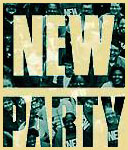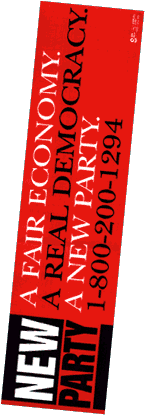

Adam Glickman
interviewed by Anthony Qaiyum on August 9, 1996

What first attracted me to the New Party was its mission to become "a multi-racial, lively and creative political organization that can, over time, break the stranglehold that corporate money and corporate media have over our political process." Sounds good, I thought, but this is politics -- spin is everything.
Then I learned that the New Party has won more than 80 of its first 120 races. It's a grassroots organization with an urban, pro-labor focus. Most importantly, it is reviving "fusion," a ballot tactic that allows it to participate in elections without becoming a spoiler party. (See part four.)
By avoiding corporate money and celebrity presidential candidates, the New Party has an honest claim to the term reform. Its determination to focus on local races during this much-hyped election year shows a commitment to long term growth that is not so apparent in Ross Perot's latest creation.
I've divided the following interview into four sections to highlight different aspects of the New Party. Hopefully, you will find the organization's ideas and actions a refreshing change of pace from the Clinton-Dole sleeper.
Anthony Qaiyum
Politics & Community Editor

Part One: Adam Glickman gives his impression of the current political landscape and discusses some of the obstacles for the progressive movement.
"You see the Democratic Party under Clinton capitulating again and again to the corporate interests and multi-national interests on trade, health care, and labor law." More...
Part Two: Glickman discusses the history, demographics, and strategy of the New Party.
"We're not controlled by one person. We're a membership based organization ... Local chapters vote on who to nominate, what campaigns to run and, what issues to focus on. It doesn't come down from the top." More...
Part Three: A comparison of the New Party and the Green Party.
"Generally we see the Green Party as more suburban, more white, more upper-middle class, and not as attentive to concerns of labor and other constituencies that we see as particularly important." More...
Part Four: An explanation of the fusion tactic, and an update on the New Party's Supreme Court fight to legalize it in all states.
"Fusion is multi-party nomination of the same candidates. So you can have one candidate on the ballot as the nominee of more than one party -- on separate ballot lines." More...
